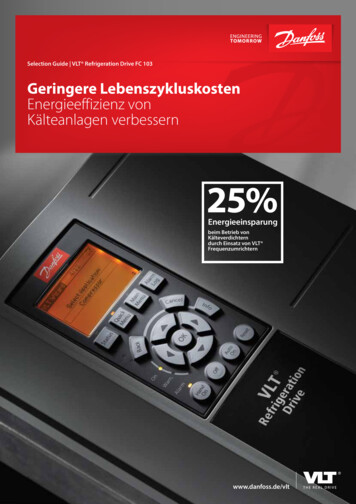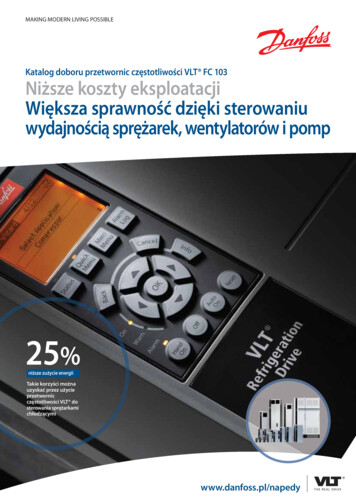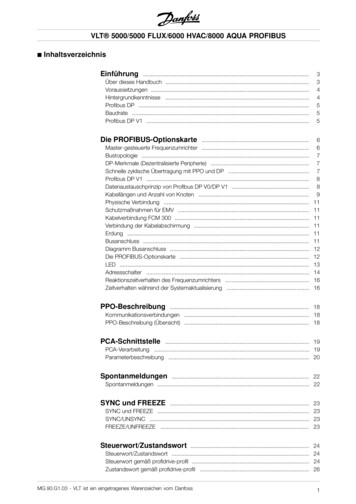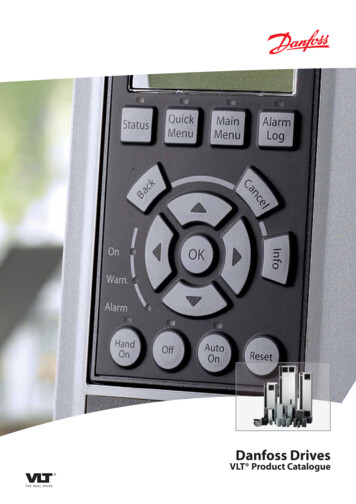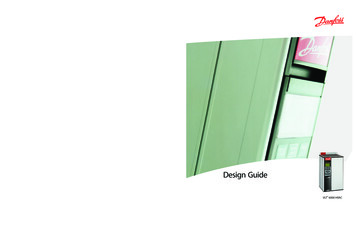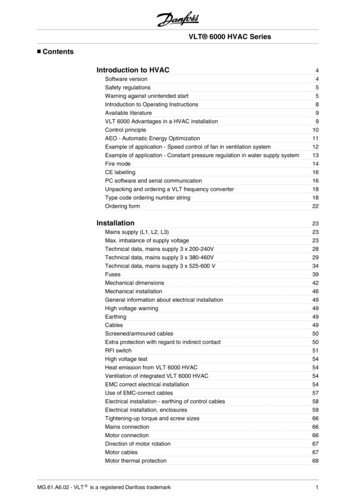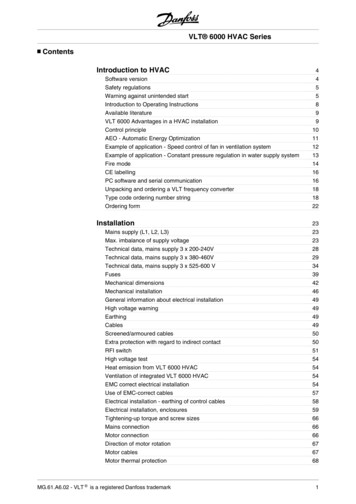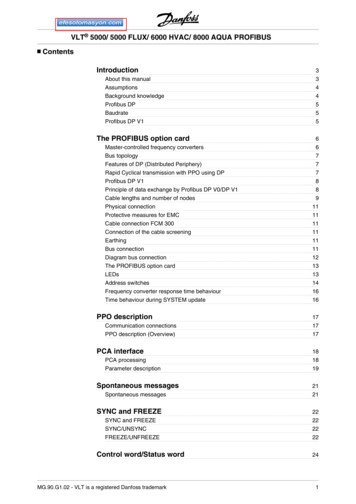
Transcription
VLT 5000/ 5000 FLUX/ 6000 HVAC/ 8000 AQUA PROFIBUSContentsIntroductionAbout this manualAssumptionsBackground knowledgeProfibus DPBaudrateProfibus DP V1The PROFIBUS option cardMaster-controlled frequency convertersBus topologyFeatures of DP (Distributed Periphery)Rapid Cyclical transmission with PPO using DPProfibus DP V1Principle of data exchange by Profibus DP V0/DP V1Cable lengths and number of nodesPhysical connectionProtective measures for EMCCable connection FCM 300Connection of the cable screeningEarthingBus connectionDiagram bus connectionThe PROFIBUS option cardLEDsAddress switchesFrequency converter response time behaviourTime behaviour during SYSTEM updatePPO descriptionCommunication connectionsPPO description (Overview)PCA interfacePCA processingParameter descriptionSpontaneous messagesSpontaneous messagesSYNC and FREEZESYNC and FREEZESYNC/UNSYNCFREEZE/UNFREEZEControl word/Status wordMG.90.G1.02 - VLT is a registered Danfoss 1717181819212122222222241
VLT 5000/ 5000 FLUX/ 6000 HVAC/ 8000 AQUA PROFIBUSControl word/Status wordControl wordStatus wordControl wordStatus word2424262728Bus reference value2929Bus reference valueExamplesExample 1: PCV ChannelExample 2: Process data from the frequency converterExample 3: Array treatmentGSD file3434DP V1 IdentificationsParametersVLT frequency converter parametersParameter accessRead/Write on VLT frequency convertersWarning and alarm messagesWarnings and alarm messagesSpontaneous messagesAdditional display readingsWarning word, extended Status word and Alarm wordStation addressExtended Diagnosis3535424243434343444647Parameter list48Appendix585859GlossaryAbbreviations usedIndex23030313260MG.90.G1.02 - VLT is a registered Danfoss trademark
VLT 5000/ 5000 FLUX/ 6000 HVAC/ 8000 AQUA PROFIBUSDanfoss A/S does not warrant that a software programproduced according to the guidelines provided in thismanual will function properly in every physical, hardware or software environment.Although Danfoss A/S has tested and reviewed thedocumentation within this manual, Danfoss A/S makesno warranty or representation, either express or implied, with respect to this documentation, including itsquality, performance, or fitness for a particular purpose.In no event shall Danfoss A/S be liable for direct, indirect, special, incidental, or consequential damagesarising out of the use, or the inability to use informationcontained in this manual, even if advised of the possibility of such damages. In particular, Danfoss A/S isnot responsible for any costs including but not limitedto those incurred as a result of lost profits or revenue,loss or damage of equipment, loss of computer programs, loss of data, the costs to substitute these, orany claims by third parties.Danfoss A/S reserves the right to revise this publication at any time and to make changes in its contentswithout prior notice or any obligation to notify previoususers of such revisions or changes.NB!Note regarding Profibus FMSIf you want to run FMS you have to purchase as follows:For VLT 5000:175Z3722 (uncoated)175Z3723 (coated)For VLT 6000 HVAC:175Z4207 (uncoated)175Z4208 (coated)It is NOT possible to run FMS from a VLT5000 FLUX or a VLT 8000 AQUA.MG.90.G1.02 - VLT is a registered Danfoss trademarkThis manual does not deal with ProfibusFMS, only with Profibus DP. However, inthe event that the communication is to bebuilt up through Profibus FMS, you shouldrequest the description MG.10.E3.yy”Profibus Product Manual“ which alsocontains a description of the Profibus FMSfunctions of the Profibus option card.About this manualThis manual is intended as both an instruction manualand a reference guide. It only broaches the basics ofthe PROFIBUS DP protocol, and only when it is necessary to provide a sufficient understanding of thePROFIDRIVE implementation of the PROFIBUS profile for frequency converters (version 2, PNO) and ofthe PROFIBUS option card for the series VLT 5000/VLT 5000 Flux/VLT 6000 HVAC/VLT 8000 AQUA byDANFOSS.UnitFCD 300FCM 300VLT 2800VLT 5000VLT 6000 HVACVLT 8000 AQUASoftware versionVer. 1.30Ver. 2.64Ver. 3.62Ver. 2.41Ver. 1.12The above table shows from which software versionsProfibus DP V1 is supported. The software version canbe read-out in parameter 624 Software versions.This manual gives detailed information of the DP V0features supported, sufficient for most programmingand maintenance activities. The DP V1 however isbriefly described. For programming purposes the Profibus DP V1 Design Guide order number MG.90.EX.YY(X is the version number, and YY the language code)might be necessary.It is suggested that readers who are not completelyfamiliar with PROFIBUS DP or the profile for frequencyconverters review the relevant literature on these subjects.Even if you are an experienced PROFIBUS programmer, we suggest that you read this manual in its entirety before you start programming, since importantinformation can be found in all chapters.The section Quick start deals with the quick start of thecommunication parameters for the DP communication.The chapter The Profibus option card contains detailsregarding the PROFIBUS option card and the establishment of the physical connection.3IntroductionIntroductionCopyrights, Limitation of Liability and Revision RightsThis publication contains information proprietary toDanfoss A/S. By accepting and using this manual theuser agrees that the information contained herein willbe used solely for operating equipment of Danfoss A/S or equipment from other vendors provided that suchequipment is intended for communication with Danfoss equipment over a PROFIBUS serial communication link. This publication is protected under theCopyright laws of Denmark and most other countries.
VLT 5000/ 5000 FLUX/ 6000 HVAC/ 8000 AQUA PROFIBUSPlease refer to section Timing for information regardingthe time behaviour.The Profibus DP V1 is an extension of the former Profibus DP V0 funcionality.The chapter PPO description presents an overview ofthe PPOs (informative data telegrams).The PCA interface as a parameter interface in the PPOis explained in chapter PCA interface.Section Parameters and data type structures containsthe description of the parameter and data structure.Chapter Spontaneous messages contains a description of spontaneous messages.The response to the ”Sync” and ”Freeze” commandsis explained in chapter SYNC and FREEZE.The Control word and Status word as essential elements of the PPOs for the operational Control, as wellas the bus reference value are explained in chapterBus reference value.Background knowledgeThe DANFOSS PROFIBUS option card is designed forthe communication with all masters that comply withthe PROFIBUS DP V0 and DP V1 standard. Thus, theassumption is made that you are familiar with the PCor PLC to be used as a master on your SYSTEM. Anyquestions regarding the hardware or software of othersuppliers are beyond the scope of this manual andoutside the responsibility of DANFOSS.In the event of questions concerning the configurationof the master-to-master communication or the configuration with a slave not manufactured by DANFOSS,you should refer to the information in the respectivemanuals.Chapter Examples contains examples for the use of thePPOs. It is recommended that readers review the examples for a better understanding of the PPOs.Chapter Parameters contains the frequency converterparameters specific to the Profibus. Warning andalarm messages and display readings specific to theProfibus are described in chapter Warning and alarmmessages.A parameter listing as an overview of all VLT 5000/VLT5000 Flux/VLT 6000 HVAC/VLT 8000 AQUA parameters can be found in chapter Parameter list.In chapter Appendix you will find the abbreviationsused in this manual. The manual concludes with ashort glossary and a detailed index for quick navigation.If you are interested in learning more about the PROFIBUS protocol in general, we recommend that youconsult the relevant, very comprehensive literature forthis purpose.AssumptionsThe manual assumes that you are using a DANFOSSPROFIBUS DP option card, together with a DANFOSSVLT frequency converter, that you are using a PLC ora PC with a serial interface as master which supportsall communication services for PROFIBUS, and thatall requirements are met and all limitations are observed which arise from the PROFIBUS standard, thePROFIBUS profile of frequency converters, and thecompany-specific implementation of PROFIDRIVE, orthose of the frequency converter drives.4MG.90.G1.02 - VLT is a registered Danfoss trademark
VLT 5000/ 5000 FLUX/ 6000 HVAC/ 8000 AQUA PROFIBUSNB!When configuring the PPO types, a distinction is made between module consistency and word consistency:The communication is established by setting the parameters indicated below.Module consistency means that a specific portion ofthe PPO is defined as a connected module. The parameter interface (PCV, length of 8 bytes) of the PPOalways has module consistency.Details regarding the adjustment of the master areprovided by the master manual and by those chaptersin this manual that deal with the particulars of thePROFIBUS interface.NB!The required GSD file is available on theInternet at http://www.danfoss.com/drivesProfibus DPParameter 904The desired informative data telegram (PPO) is setupin master configuration. The actual PPO type can beread out in P904. The master sends the PPO type ina configuration telegram in the Profibus DP startphase.Parameter 918This sets the address of the frequency converter station – one specific address per frequency converter.For further information, please refer to the section Station address in this manual.Parameter 502 -508By setting the parameters 502-508 you will be able toselect have to control over the bus.Parameter 512Allows the choice of Control word/Status word type.For further information, please refer to the sectionControl word/Status word this manual.Word consistency means that a specific portion of thePPO is divided into individual data sectors of wordlength (16 bits).The process data of the PPO may have either moduleconsistency or word consistency, as desired.Some PLCs, such as Siemens S7, require specialfunctions to call modules that are longer than 4 bytes(in the case of Siemens: ”SFC”, see master manual).This means that the PCV interfaces of the PPOs canonly be called through the SFC functions in the caseof Siemens (S7).Profibus DP V1A detailed description of the DV V1 features supportedcan be found in the “Profibus DP V1 Design Guide”order number MG.90.EX.YY.Further specifications might be helpful:-Technical Guide “PROFIBUS -DP Extensions to EN 50170 (DPV1)” V2.0, April 1998,Order no. 2.082-Draft PROFIBUS Profile PROFIDRIVE Profile Drive Technology V3.0 September 2000,Order no. 3.172NB!In order to activate a change of parameter918 the power of the frequency convertermust be cycled.BaudrateThe FCM 300, FCD 300 and VLT 2800 adjust automatically to the Baudrate configurated from the master.MG.90.G1.02 - VLT is a registered Danfoss trademark5IntroductionQuick startDetails regarding the programming of the usual frequency converter parameters may be gathered fromthe manual for the VLT 5000/VLT 5000 FLUX/VLT6000 HVAC/VLT 8000 AQUA series.
VLT 5000/ 5000 FLUX/ 6000 HVAC/ 8000 AQUA PROFIBUSMaster-controlled frequency convertersThe PROFIBUS Fieldbus was designed to give youunprecedented flexibility and command over your controlled SYSTEM. The PROFIBUS will perform as anintegrated part of your frequency converter, giving youaccess to all parameters relevant to your application.The frequency converter will always act as a slave, andtogether with a master it can exchange a multitude ofinformation and commands. Control signals such asspeed reference, start / stop of motor, reverse operation, etc. are transmitted from the master in the form ofa telegramme. The frequency converter acknowledges receipt by transmitting status signals, such as running, on reference, motor stopped and so on to themaster. The frequency converter may also transmitfault indications, alarms and warnings to the master,such as Overcurrent or Phaseloss.The PROFIBUS communicates in accordance with thePROFIBUS field bus standard, EN 50170, part 3. It canthus exchange data with all masters that meet thisstandard; however, this does not mean that all services available in the PROFIDRIVE profile standard aresupported. The PROFIBUS profile for frequency converters (version 2 and partly version 3, PNO) is a partof PROFIBUS which supports only those services thatconcern applications with speed control.Communication partnersIn a control SYSTEM the frequency converter will always act as a slave, and as such it may communicatewith a single master or multiple masters depending onthe nature of the application. A master may be a PLCor a PC that is equipped with a PROFIBUS communication card.6MG.90.G1.02 - VLT is a registered Danfoss trademark
VLT 5000/ 5000 FLUX/ 6000 HVAC/ 8000 AQUA PROFIBUSBus topology-PLC communicates with telegrams of constant length-Fits to time critical requirementsSingle master operation with DP V0-1.Setpoint transmission2.Actual value feedback3.New set points computed4.New set point transmission5.Parameter Read - using PCV channel6.Parameter Write - using PCV channel7.Read parameter description - using PCVchannelSingle masterFeatures of DP (Distributed Periphery)-Is used by several PLC manufacturers for remote peripheral I/O communication.-Supports cyclical communication.-SRD (Send Receive Data) service gives fastcyclical exchange of process data betweenmaster and slaves.-Freeze and synchronize function is supported.-Fixed data structure.-Fixed telegramme size.-Occupies I/O memory space in PLC proportional to the number of slaves employed,Rapid Cyclical transmission with PPO using DPwhich may limit the number of participants.Additional data require additional I/O memoryspace.DP should be used when fast cyclical process controlis needed. Such a concept would typically call for single master operation with a limited number of slavestations. A high number of slaves will increase theSYSTEM response time.This could also be the case where control loops areclosed over the bus. As a very fast alternative it is ofcourse possible to close the control loop outside thebus.Control of the drives during normal operation is oftenvery time critical, but it involves very few data, such ascontrol commands and speed reference. DP is optimized for fast cyclical communication.Parameter up-/downloads can be achieved by usingthe PCV part of the so-called Parameter - Process dataObjects - PPO types 1, 2 or 5, see drawing in paragraph PPO description.MG.90.G1.02 - VLT is a registered Danfoss trademark7The PROFIBUS optioncardCyclical transmission (PLC)
VLT 5000/ 5000 FLUX/ 6000 HVAC/ 8000 AQUA PROFIBUSProfibus DP V1-Cyclical data exchange (DP V0).The Profibus DP extension DP V1 offers additional tothe cyclical data communication an acyclical communication. This feature can be used by a DP master type1 (e.g. PLC), as well as a DP master type 2 (e.g. PCtool).-Acyclical read/write on parameters.The acyclical connection is fixed, and can not bechanged during operation.Features of a Master type 2 connection:-Initiate / Abort acyclical connection.-Acyclical read/write on parameters.The acyclical connection can dynamically be established (Initiate) or removed (Abort) even when a master class 1 is active on the network.The DP V1 acyclical connection can be used for general parameter access as an alternative to the PCVparameter channel.Features of a Master type 1 connectionPrinciple of data exchange by Profibus DP V0/DPV1In a DP cycle the MC 1 will first update the cyclicalprocess data for all slaves in the SYSTEM. After thatthe MC 1 has the possibility of sending one acyclicalmessage to one slave. If a MC 2 is connected, the MC1 will handle over the Token to MC 2 who now is aloudto send one acyclical message to one slave. After that,the token is handled back to the MC 1, and a new DPcycle is started.8MC1: Master Class 1MG.90.G1.02 - VLT is a registered Danfoss trademark
VLT 5000/ 5000 FLUX/ 6000 HVAC/ 8000 AQUA PROFIBUSPlease note that a repeater switched between twosegments represents a node in both segments. Thenumber of frequency converters is based on a SYSTEM with only one master. In the case of multiplemasters, the number of frequency converters must bereduced accordingly.The total stub line length of a segment is limited asfollows:Stub line lengthTransmission speed9.6-93.75 kBaud187.5 kBaud500 kBaud1.5 MBaud3-12 MBaudMaximum total bus cable lengthTransmission speed1 segment:2 segments:32 nodes (31 frequen- 64 nodes (1 repeater,cy converters) [m]61 frequency converters) [m]9.6-187.5 kBaud10002000500 kBaud4008001.5 MBaud2004003-12 MBaud100200MG.90.G1.02 - VLT is a registered Danfoss trademarkMax. stub line length persegment [m]96753010none3 segments:96 nodes (2 repeater,91 frequency converters) [m]300012006003004 segments:128 nodes (3 repeater,121 frequency converters) [m]400016008004009The PROFIBUS optioncardCable lengths and number of nodesThe maximum cable of a segment depends on thetransmission speed. The total cable length includesstub lines, if applicable. A stub line is the connectionfrom the main bus cable to each node if a ”T” connection exists instead of a direct connection of the mainbus cable to the nodes; cf. the stub line length. Thefollowing table shows the maximum permitted cablelengths and the maximum or frequency converterswith 1, 2, 3 or 4 bus segments.
VLT 5000/ 5000 FLUX/ 6000 HVAC/ 8000 AQUA PROFIBUSThe indicated lengths in the tables are valid on thecondition that bus cables with the following propertiesare used:- Impedance:135 to 165 Ohm at a measuringfrequency of 3 to 20 MHz- Resistance: 110 Ohm/km- Capacity: 30 pF/m- Damping:max. 9 dB across the entire cablelength- Cross-section:max. 0.34 mm pursuant to AWG22- Wire type:twisted pair, 1 x 2 or 2 x 2 or 1 x 4conductors- Shieldingcopper-braided or braided andfoil laminatedIt is recommended to use the same cable type throughout the entire network in order to avoid mismatches ofthe impedance.The figures in the following description indicate themaximum permitted number of stations in each segment. These figures do not refer to the station addresses, since each station in the network must havean unambiguous address.Segment 1Segment 2Segment 3Segment 410MG.90.G1.02 - VLT is a registered Danfoss trademark
VLT 5000/ 5000 FLUX/ 6000 HVAC/ 8000 AQUA PROFIBUSPhysical connectionEarthingThe PROFIBUS option card will be connected to thebus line (data line) at terminals 62 and 63. Data line”B” (TxD/RxD-P) will be connected to terminal 62 anddata line ”A” (TxD/RxD-N) to terminal 63. A master witha voltaically insulated bus driver and overvoltage protection (e.g. Z diode) is recommended.It is important to connect all stations linked to the PROFIBUS network to the same earth potential. The earthing must have a low high-frequency impedance. Thiscan be achieved by connecting a protective housingsurface which is as large as possible to earth, for example by mounting the frequency converter to a conductive rear wall.It is recommended to carry out the following protectivemeasures for EMC in order to ensure a trouble-freeoperation of the PROFIBUS network. Additional notesconcerning the subject of EMC can be found in theproject manual for the VLT 5000 series (MG.50.Cx.yy)and in the manual for the Profibus master.Especially in the case of large distances between thestations of a PROFIBUS network, the additional use ofpotential equalization cables to connect the individualstations to the same earth potential may be necessary.The PROFIBUS optioncardProtective measures for EMCBus connectionNB!The applicable national and local regulations, for example with respect to protective earthing, must be observed.Cable connection FCM 300The PROFIBUS communication cable must be keptaway from motor and brake resistor cables to avoidcoupling of high frequency noise from one cable to theother. Normally a distance of 200 mm is sufficient, butit is generally recommended to keep the greatest possible distance between the cables, especially wherecables are running in parallel over long distances.62 RxD/TxD-P red cable63 RxD/TxD-N green cableIf the PROFIBUS cable has to cross a motor and braking resistance cable, it should occur at a 90 angle.Connection of the cable screeningThe shielding of the PROFIBUS cable always needsto be of a large-area, low-impedance type on bothsides. As a matter of principle, the screen should beput up with a large area and low impedance at allPROFIBUS stations. It is very important to have anearth connection with low impedance even at high frequencies. This can be achieved by connecting theshield surface to earth, for example with the help of acable bow or a conductive cable connector.The frequency converter is equipped with various terminals and supports in order to provide a flawlessshielding of the PROFIBUS cable. The shield connection is shown in the following diagram.MG.90.G1.02 - VLT is a registered Danfoss trademark11
VLT 5000/ 5000 FLUX/ 6000 HVAC/ 8000 AQUA PROFIBUSDiagram bus connectionIt is important to terminate the bus line correctly. Mismatches of the impedance may lead to reflections inthe line and cause incorrect transmissions.-please make sure that it is voltaically separated from the power supply cable.The PROFIBUS option card is equipped witha suitable termination which can be activatedby the switches 1 and 2 at the switch blockS1 directly to the right above the terminalblock MK 1B. The bus termination is activewhen the switch is in the ”ON” position.NB!The switches must never be set in opposite directions. Both switches must be setto ON or OFF.12-Most masters and repeaters are equippedwith their own termination.-If an internal termination circuit in the form ofthree resistors is connected to the bus line, a5 V direct voltage must be used. Attention:MG.90.G1.02 - VLT is a registered Danfoss trademark
VLT 5000/ 5000 FLUX/ 6000 HVAC/ 8000 AQUA PROFIBUSThe PROFIBUS optioncardThe PROFIBUS option cardLEDsThere are four LEDs on the PROFIBUS option card:LD1 and LD4: Flickering (very rapid blinking),when data are being exchangedthrough the option card. Comment:with each ”flicker” of the LEDs, thefrequency converter is sending atelegram.LD2 and LD3: Shining, when the option card is initialized and ready for the data exchange, or when data are alreadybeing exchanged. Blinking, whenthe function for the automatic baudrate determination attempts to determine the current baud rate. Note:a faulty connection of the data linemay also cause blinking of theLEDs. (see “Physical connection”).MG.90.G1.02 - VLT is a registered Danfoss trademark13
VLT 5000/ 5000 FLUX/ 6000 HVAC/ 8000 AQUA PROFIBUSAddress switchesThe station address can be set in parameter 918 orthrough a hardware switch (S2, 1-4 and S3, 5-7 on thePROFIBUS option card).The setting of an address through parameter 918 isonly possible when the address switches are set to 125.Each slave must have an unambiguous address. Theaddress is the binary value set for the switches, cf. thetable below. The modification of the address switchesoccurs during the next turn-on procedure. See alsosection Station Address.Switches 1-7 (switch 8 is not used)23451Address switch position (1 ON, 0 0000Switches 1-7 (switch 8 is not used)23451Address switch position (1 ON, 0 000000000011111111111111111111111MG.90.G1.02 - VLT is a registered Danfoss trademark
Switches 1-7 (switch 8 is not used)23451Address switch position (1 ON, 0 111MG.90.G1.02 - VLT is a registered Danfoss trademarkThe PROFIBUS optioncardVLT 5000/ 5000 FLUX/ 6000 HVAC/ 8000 AQUA PROFIBUS15
VLT 5000/ 5000 FLUX/ 6000 HVAC/ 8000 AQUA PROFIBUSTimingTime behaviour during SYSTEM updateFrequency converter response time behaviourThe SYSTEM update period is the time required toupdate all slaves of the network when cyclical communication is used.The period for the update through the PROFIBUS connection can be subdivided into two portions:1.The communication period, i.e. the time required to transmit data from the master to theslave (frequency converter with PROFIBUSoption), and2.the internal update period, i.e. the time required to transmit data between the frequency converter control card and the PROFIBUSoption card.The update time of a single slave is composed of boththe communication period (depending on the baudrate) and the station delay (TSDR) in the slave, and ofthe delay in the master associated with the station.The station delay (TSDR) is the delay time from themoment when a station receives the last bit of a telegram to the moment when it sends the first bit of thenext telegram. The station delay is defined by two parameters: the minimum station delay (TSDRmin) andthe maximum station delay (TSDRmax).Current station delay for the PROFIBUS option:- DP: 11 bit timesCurrent master station delay:- This information must be provided by the manufacturer of the respective PROFIBUS master.The communication period (tcom) depends on the respective transmission speed (baud rate) and the typeof master being used. The shortest achievable communication period is approximately 30 msec per slavewith the frequency converter PROFIBUS option whenDP communication with a data quantity of 4 bytes(PPO type 3) at 12 Mbaud is used. The communicationperiod increases with more data or lower transmissionspeeds.The internal update period (tint) depends on the respective data as there are different channels for thetransmission of data, with time-critical data, such asthe Control word, being given the highest priority. Theinternal update time for the respective data types islisted below.Example- DP master with 1.5 MBaud and PPO type 3 (4 bytedata); the assumption here is for 50 bit times as masterTSDR.Time [msec]0ActionMaster starts data transmissionLast bit received in slaveSlave station delaySlave starts data transmissionLast bit received in masterMaster station delay(50 bit times » 0.033)Master ready for data transmission tonext slaveDataUpdate time, tintControl word/main reference value2 msec.(Part of PPO)Status word/respective output fre2 msec.quency (Part of PPO)Parameter Read (PCD 1-8)2 msec.Parameter Write (PCD 1-2)40 msec.Parameter Write (PCD 3-4)80 msec.Parameter Write (PCD 5-8)160 msec.Parameter Read (PCV)20 msec.Parameter Write (PCV)20 msec.Acyclical data (read, write)20 msec.16MG.90.G1.02 - VLT is a registered Danfoss trademark
VLT 5000/ 5000 FLUX/ 6000 HVAC/ 8000 AQUA PROFIBUSCommunication connectionsPPO, Parameter Process Data ObjectCommunication pursuant to PROFIBUS DP, i.e.EN50170 part 3, is supported.Accordingly, a master must be used that supportsPROFIBUS DP.PPO description (Overview)A feature of the PROFIBUS profile for frequency converters is a communications object designated as”PPO”, i.e. ”parameter process data object”.All cyclical informative data are transmitted via PPOs.Thus, PPOs form the framework for the data traffic.One of the PPOs described in the following must beused in the case of DP communication.The actual PPO type can be readout in parameter 904.The process data portion consists of a fixed part(4 bytes) and a parameterizable part (8 or 16 bytes).The Control word and speed reference value are transmitted to the frequency converter in the fixed portion,whereas the Status word and current output frequency are transmitted by the frequency converter. In theparameterizable portion, the user selects which parameters are to be transmitted to the frequency converter (parameter 915) and which are to be transmittedby the frequency converter (parameter 02 - VLT is a registered Danfoss trademarkProcess cteristics (Bytes 1, 2)PCA handling see section ExamplesSubindex (Byte 3)m (Byte 4 is not used)Parameter value (Bytes 5 to 8)ControlwordSee section ExamplesStatuswordMain reference valueMain actual value (Actual output frequency)17PPO descriptionA PPO may consist of a parameter portion and a process data portion. The parameter portion may be usedfor reading and/or updating of parameters (successively).
VLT 5000/ 5000 FLUX/ 6000 HVAC/ 8000 AQUA PROFIBUSPCA processingThe master controls and monitors frequency converterparameters through the PCA portion of the PPOs type1, 2 and 5 and requests a response from the frequencyconverter (slave). In addition to the parameter processing, the frequency converter can also transmit aspontaneous message.Requests and responses involve an acknowledgementexchange (a so-called handshake) which cannot beworked off in stack operation. This means that themaster, when s
the manual for the VLT 5000/VLT 5000 FLUX/VLT 6000 HVAC/VLT 8000 AQUA series. The communication is established by setting the pa-rameters indicated below. Details regarding the adjustment of the master are provided by the master manual and by those chapters in this manual that deal with the particulars of the PROFIBUS interface. NB!

